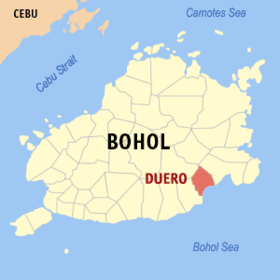Duero
Appearance
| Duero | |
|---|---|
| Baley na Filipinas | |
 | |
 Lokasyon na Duero | |
 | |
| 9°43′12″N 124°24′0″E | |
| Dalin | Filipinas |
| Angipaletnegan | 1862 |
| Barangay | 21 |
| Kaawang | |
| • Katiponan | 97.30 km2 (37.57 sq mi) |
| Elebasyon | 152 m (499 ft) |
| Bilang na too (Mayo 1, 2020)[1] | |
| • Katiponan | 18,861 |
| • Densidad | 190/km2 (500/sq mi) |
| Economia | |
| • Clase | kumapat ya klase ya baley |
| • Ingresos | ₱96,539,916.9143,754,521.3347,792,173.6854,360,767.0060,558,883.4066,568,880.6977,484,997.7288,844,339.4485,949,043.54102,236,817.71137,246,242.75 (2020) |
| • Activos | ₱253,410,665.3568,731,556.6768,187,109.9982,283,420.37105,956,034.97137,935,814.02170,012,219.41176,576,162.57210,926,813.16291,153,247.69388,848,785.14 (2020) |
| • Pasivos | ₱41,078,008.7025,465,808.3621,971,036.8728,717,364.8730,533,978.7150,436,270.9866,047,548.9034,525,248.1543,621,377.3644,440,557.6290,402,153.90 (2020) |
| • Gastos | ₱87,239,782.3040,233,646.5041,126,386.1641,632,192.8644,870,560.1054,250,476.7059,769,766.0065,160,787.1775,625,905.1786,610,219.66106,650,307.20 (2020) |
| Kodigo na postal | 6309 |
| Kodigo na lugar | 38 |
Say Duero et kumapat ya klase ya baley ed luyag na Bohol, Filipinas. Unong ed 1 Mayo 2020 census, say populasyon to et 18,861 totoo tan 4,517 abong. Walay kabaleg tan sukat to ya 97.30 sq. km. Say zip code to et 6309.
Saray barangay
[dumaen | dumaen so pinanlapuan]- Alejawan
- Angilan
- Anibongan
- Bangwalog
- Cansuhay
- Danao
- Duay
- Guinsularan
- Itum
- Langkis
- Lobogon
- Madua Norte
- Madua Sur
- Mambool
- Mawi
- Payao
- San Antonio (Pob.)
- San Isidro
- San Pedro
- Imelda
- Taytay
Demograpiko
[dumaen | dumaen so pinanlapuan]| Taon | Pop. | ±% p.a. |
|---|---|---|
| 1903 | 6,853 | — |
| 1918 | 8,314 | +1.30% |
| 1939 | 9,272 | +0.52% |
| 1948 | 8,939 | −0.41% |
| 1960 | 8,929 | −0.01% |
| 1970 | 9,965 | +1.10% |
| 1975 | 11,522 | +2.95% |
| 1980 | 11,619 | +0.17% |
| 1990 | 14,242 | +2.06% |
| 1995 | 14,299 | +0.07% |
| 2000 | 16,485 | +3.10% |
| 2007 | 17,254 | +0.63% |
| 2010 | 17,580 | +0.68% |
| 2015 | 17,876 | +0.32% |
| 2020 | 18,861 | +1.06% |
| Reperensiya: Philippine Statistics Authority[2][3][4] | ||
Saray reperensiya
[dumaen | dumaen so pinanlapuan]- ↑ "2020 Census of Population and Housing (2020 CPH) Population Counts Declared Official by the President". Hulyo 7, 2021. https://psa.gov.ph/content/2020-census-population-and-housing-2020-cph-population-counts-declared-official-president.
- ↑ Census of Population (2015). "Region VII (Central Visayas)". Total Population by Province, City, Municipality and Barangay. PSA. Retrieved 29 June 2016.
- ↑ Census of Population and Housing (2010). "Region VII (Central Visayas)". Total Population by Province, City, Municipality and Barangay. NSO. Retrieved 29 June 2016.
- ↑ Censuses of Population (1903–2007). "Region VII (Central Visayas)". Table 1. Population Enumerated in Various Censuses by Province/Highly Urbanized City: 1903 to 2007. NSO.
